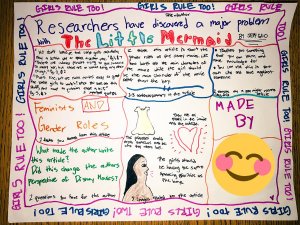6 Ways to Make the Most of Classroom Movies
A Twitter thread on how to elicit real learning from movies draws over 150 teachers—and produces some fantastic ideas.
Your content has been saved!
Go to My Saved Content.When I was a young high school English teacher, I always concluded our reading of Romeo and Juliet with a viewing of Franco Zeffirelli’s film version of the play.
I would stop every 15 or 20 minutes to ask questions about the director’s choices. “Why might a scene or a few lines of text have been edited out? Did this or that character look or sound like you imagined?” That stop-and-start approach is a widely used strategy, according to a recent Twitter thread among teachers on best practices for integrating movies into the classroom.
But like many of the 150-plus teachers who participated in the discussion, I came to feel that the constant disruptions were robbing my students of a good viewing experience, and the pauses didn’t seem to drive a lot of productive dialogue. No it wasn’t until, in a misguided effort to speed through a brief bit of nudity in Zeffirelli’s film, I fumbled and hit the pause button—and then couldn’t get the film started again—that I finally landed upon the right strategy to drive real engagement.
Unfortunately, that’s not a very replicable piece of advice. And it’s very, very difficult to get the class to settle down again.
Many experienced teachers in the thread did feel that students should be able to just watch the film: “Do they have to ‘do something’?” asked Maire from New Jersey. “Sometimes we think we have to fill everything with work, but watching the movie and enjoying it is OK too.” Let them eat popcorn and enjoy themselves, a few others chimed in.
While periodic interruptions to invite discussion might well meet your objectives—one technique even allows for continuous dialogue in real time—teachers suggested a much broader range of powerful before- and after-viewing strategies for learning from classroom movies. We’ve selected a few of the best.
1. Prep Work and Predictions
If you’re thinking of letting students watch a movie without a lot of interruptions, some prep work makes sense. Ask students what they’re eager to see in the movie version, suggested Laura Bradley, garnering 30 likes from other teachers, or have them offer “predictions about how certain characters or scenes might be portrayed—that way they’ll be anticipating and watching for them.”
Asking students to predict how the movie version of a book will handle critical scenes or characters gets them to think about the mechanics of compelling plots—the gears that make stories fascinating.
Be sure to cross-examine their reasons, says Kirsten Dirks, because “having students explain how/why they think the way they do stretches their thinking” and pushes them to consider alternatives.
2. Better Ways to Compare and Contrast
For students who read the book and subsequently watch the movie version, dozens of teachers suggested compare and contrast activities—asking students to confront challenging questions of format (visual versus written), narrative arc (how changes in plot affect the other elements of the story), and duration (what scenes can be sacrificed to satisfy time constraints).
A winning tactic for compare and contrast exercises: Dozens of teachers use Venn diagrams, often paired with Post-its: “For The Lion, the Witch, and the Wardrobe,” said Cynthia Blanco, “I put up a giant Venn diagram on the wall and gave kids sticky notes to write their similarities and differences. They enjoyed this. Plus, it got them moving.”
Follow-on activities like group discussions about why the director made the adjustments—and how they changed the story—were popular. Several teachers said that the “which is better, the book or the movie?” prompt provided good, enriching fodder for debates and group or pair discussions.
3. Make Connections to Life
Inevitably kids, like adults, project themselves into the movies they watch. Teachers can drive deeper engagement, reflection, and comprehension by tapping into this natural tendency: “I love using connection prompts (text, self, world) with movies,” said Aaron Tarbell, drawing strong agreement from other teachers. Doing so “always starts good discussions that are led by what the students pick up on, not what I tell them is important.” Discussions can come at intervals during the movie, or in after-viewing activities like Socratic circles or fishbowls.

Dozens of educators also suggested sketchnotes as a way for students to create fun, multimedia reflections that capture scenes, quotes, or characters that inspired them. A few others offered one-pagers—a multimedia format that’s similar to sketchnotes and allows students to express their insights in a creative, free-flowing medium.
4. Use Interactive Tech
If you’re teaching in a 1:1 school or your students are allowed to bring in devices, tools like Google Classroom, Padlet, and Edpuzzle can enable interactive, whole-class discussions in real time, or allow teachers to pose questions and probe for comprehension in the classroom as the story unfolds.
“Edpuzzle now has a ‘Live’ feature where you watch video as a class and questions can be placed in the video and students answer on their own device,” wrote Sarah Simon, and a quick cross-check on Edpuzzle’s website confirms that.
5. Assign Characters
Delving into complex questions of a character’s motivations, needs, and traits is a critical dimension of literacy—and movies are a great way to explore how characters are developed in fiction. Teachers in the Twitter thread suggested assigning students to watch one character closely while “noting aspects of [their] development,” as Mrs. Love put it, or trying to untangle the thinking behind a cascade of difficult decisions.
After tracing the arc of the assigned character, Teach2Think suggested, students can attempt to “express the character’s personality in sketches,” which can be short paragraphs or artworks annotated to explain the students’ artistic decisions. High school teacher Pete Senger added an unexpected twist to character analysis, suggesting that students might “write an obituary about the main character summarizing their life.”
6. Have Students Construct an ‘Anatomy of a Scene’
Using the New York Times format as a model, said Susan Barber, have students create their own “anatomy of a scene”—and 18 other teachers quickly approved of the idea. Looking closely at the elements of a single scene, from voice-over to lighting, camera angles, and character development, pushes students to examine the finer points of visual storytelling.
You can have students mimic The New York Times faithfully using video-making tools popular among teachers, like Screencastify, Adobe Spark, or Screencast-O-Matic, or ask students to create paper-and-pencil storyboards of a movie sequence, annotating their thinking as they go. If you’re looking for a tech tool to create storyboards, we’ve heard good things about Storyboard That.
